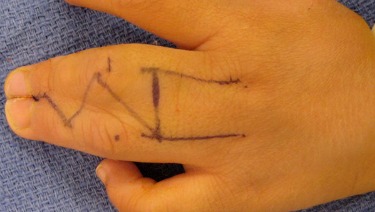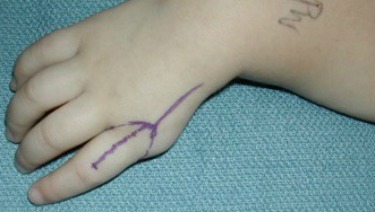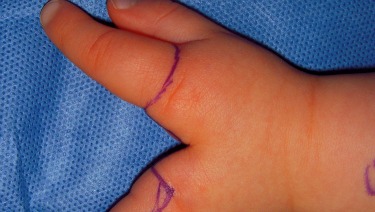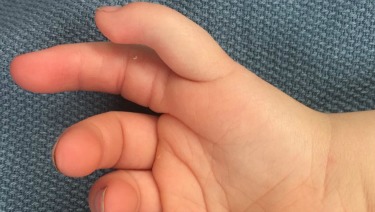Of the 1% to 2% of babies born with congenital defects, 10% are born with malformations to the hand. These anomalies occur in early pregnancy and are sometimes diagnosed by ultrasound during pregnancy. When they are not, they often come as a surprise to parents. The cause of congenital hand anomalies is unknown.
Depending on the type and extent of a hand malformation, some babies may have little trouble adapting and functioning well. Others, however, may face various challenges as they grow and learn:
Developmental problems such as delayed or deficient motor skills
Difficulties with activities of daily living activities and basic self-care skills
Limitations on certain types of exercises and sports
Potential emotional and social harm from childhood teasing about appearance
If child is functioning well and is happy, treatment is not always necessary. If a child is having difficulty doing the things he or she wants to do because of a hand malformation, treatment options may be available.
Treatment Options
The most important goal of any treatment for hand malformations is to help a child function as independently as possible. Your pediatrician will often provide referrals to pediatric plastic surgeons or pediatric orthopedic surgeons. Treatment may involve:
Types of Hand Malformations
Pediatric plastic and orthopedic surgeons diagnose and treat children with all types of hand malformations. There are many types. The following are those most often seen.
Extra Digits (Polydactyly)
Polydactyly is the most common congenital hand deformity. It affects boys and girls equally. A baby born with polydactyly has more than five fingers on one hand. An extra finger is often a small piece of soft tissue that can be simply removed. Sometimes, the extra finger contains bones but not joints. Very rarely, the extra finger is a fully functioning digit. A baby may be born with several extra fingers. There are different types of polydactyly:
Preaxial polydactyly: Involves having an extra thumb. It is more common in Caucasians. A pediatric surgeon can remove the extra bone and skin and repair the tendons.
Postaxial polydactyly: Involves having extra fingers on the opposite (the "pinkie" side). It is more common in African-Americans. These may occur as complete, separate fingers or just as small stumps. Stumps can be treated by a hand specialist in the office.
Central polydactyly: Extra fingers can be located between center fingers, although this is less common.
Fused Fingers (Syndactyly)
 Syndactyly is one of the most common birth defects of the upper limbs—seen in as many as 1 in every 2,000 live births. This condition occurs when two or more fingers fail to separate when a baby is in the womb—resulting in "webbed" fingers at birth. It usually involves the middle and ring fingers.
Syndactyly is one of the most common birth defects of the upper limbs—seen in as many as 1 in every 2,000 live births. This condition occurs when two or more fingers fail to separate when a baby is in the womb—resulting in "webbed" fingers at birth. It usually involves the middle and ring fingers.
Syndactyly affects twice as many boys as girls. There is often a family history, and these cases often involve both fingers and toes.
Surgery is generally needed before a child is 18 months old to separate the fingers or toes and may require extra skin to be taken from a separate area on the body, depending on the extent the fingers were joined. Categories of the condition include:
Complete syndactyly: The skin is fused all the way to the tip of affected fingers or toes.
Incomplete syndactyly: The fingers or toes are joined only part of the way to the tips.
Simple syndactyly: The fingers or toes are joined by skin and soft tissue only.
Complex syndactyly: The bones of fingers next to each other are fused.
Underdeveloped Hand (Symbrachydactyly)
Babies born with symbrachydactyly have small or missing fingers. They also may have webbed fingers or a short hand or forearm.
Mild symbrachydactyly: The hand has slightly short, mobile fingers with minor webbing. The hand bones and some of the finger bones and the thumb are present.
Moderate symbrachydactyly: Most or all of the finger bones are missing, and the baby has small projections of skin and soft tissue. The thumb is usually present, but it may be short.
Severe symbrachydactyly: The baby has either a partial thumb or no thumb and no fingers.
Club Hand
 Babies born with club hand are partially or completely missing one of the two long bones that make up the forearm—the radius or the ulna. As a result, the forearm may be shorter than normal. The hand turns inward, causing limited range of motion at the wrist. A child with the condition may have trouble performing tasks that require his or her hands. The condition is usually more prominent on one side of the hand or the other—the radial (thumb) side or the ulnar (little finger) side.
Babies born with club hand are partially or completely missing one of the two long bones that make up the forearm—the radius or the ulna. As a result, the forearm may be shorter than normal. The hand turns inward, causing limited range of motion at the wrist. A child with the condition may have trouble performing tasks that require his or her hands. The condition is usually more prominent on one side of the hand or the other—the radial (thumb) side or the ulnar (little finger) side.
Radial club hand: Children with club hand on the radial side (radial dysplasia) often have a short forearm and wrist curved toward the thumb side. Once a baby is between 6 and 12 months of age, surgery may be recommended to straighten the forearm bone and to fix the tendons. The condition may also be related to other medical syndromes such as Fanconi anemia, Holt-Oram syndrome, and VATER syndrome.
Ulnar club hand: This condition is less common than radial club hand and is usually unrelated to other syndromes. It can range from mild to more severe cases with the baby's wrist to be in a fixed and bent position toward the little-finger side of the hand. The thumb by be deformed or absent.
Cleft Hand (Ectrodactyly)
 Cleft hand (also called ectrodactyly or split hand) is when the middle part of the hand develops abnormally. Babies with this condition are missing one or more central fingers on the hand. There are generally two types:
Cleft hand (also called ectrodactyly or split hand) is when the middle part of the hand develops abnormally. Babies with this condition are missing one or more central fingers on the hand. There are generally two types:
Typical cleft hand: V-shaped and usually missing or partially missing middle fingers. Both hands are usually affected, and sometimes the feet are, too. There is often a family history of this type of cleft hand.
Atypical cleft hand: U-shaped and usually involves only one hand. This type of cleft hand is not often inherited. Atypical cleft hand may be a symptom of Poland syndrome.
Small (Hypoplastic) Thumbs
 A hypoplastic thumb did not fully form in the womb or was missing altogether at birth. Treatment depends on how secure or stable the joint is that connects the base of the thumb to the wrist.
A hypoplastic thumb did not fully form in the womb or was missing altogether at birth. Treatment depends on how secure or stable the joint is that connects the base of the thumb to the wrist.
Children with stable joints tend to use the thumbs in regular play. Children whose have unstable joints tend to ignore the thumb.
For stable thumb-wrist joints, reconstructive surgery is generally recommended to build up the thumb and its tendons. For loose or floating unstable joints, the small thumb is removed and the index finger is converted to a thumb.
Trigger Thumb
Sometimes babies are born with an abnormality of the tendon in the thumb that makes it difficult for it to bend it. This condition may disappear on its own by about age 1. Other times, surgical correction may be recommended before age 3 to release the tendon and allow for the thumb to properly function.